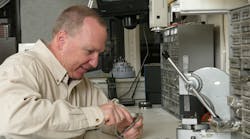Electric handpieces: Protecting your investment (part 2)
Editor's note: This article is the second in a series about handpieces. Part 1 of the series, published in August 2019, focused on what to consider when purchasing a handpiece, including how to spot counterfeit handpieces and handpieces that haven't been FDA-approved.
High-speed electric attachments have been in use in dentistry for more than 15 years, although they have increased in popularity recently, as more dentists and dental schools are making the switch from air-driven handpiece technology to electric. High-speed electric handpieces are universally denoted by a color-coded red ring around the base. They are also known as one-to-five (1:5) increasing attachments because the gearing inside the body of the handpiece increases the bur speed up to 200,000 rpm, from the motor speed of 40,000 rpm.
Electric handpieces hold several advantages over air-driven handpieces—chiefly, cutting power to the bur is delivered at a constant level throughout the entire procedure after the foot control is depressed, unlike air-driven handpieces. An air-driven handpiece may rotate at higher free-running speeds, typically in the 400,000 rpm range, but that speed decreases immediately after contact with the tooth structure is initiated. An electric handpiece will cut with continuous, consistent power without ever bogging down during a procedure. This can translate into reduced treatment times and less time for your patient in the chair. The electric motor speed is also variable; most models come with a digital readout so you can set the exact speed you prefer. Electric handpieces operate at a noticeably lower decibel range than air-driven handpieces, which can reduce patient objections to the unsettling conventional “drill noise.”
Electric attachments also rotate with a higher degree of concentricity, which is defined as the bur rotating on its own axis, than air-driven handpieces. With air-driven handpieces, the turbines are mounted on flexible O-rings that allow for more movement of the turbine inside the handpiece head. Electric head bearings may be positioned against O-rings, but the internal head dimensions are machined to much tighter tolerances, so the bur will not “travel” as much as it turns against tooth structure, offering the clinican typically smoother margins.
Upgrading your office to electric handpiece technology can be a considerable investment, requiring one motor per operatory. Electric motors range in cost from around $1,700 up to $3,600, depending on the features offered. High-speed attachments cost anywhere from $1,300 to $1,600, depending on the manufacturer. Most attachments come with a two-year warranty, and some manufacturers will extend that warranty even longer if you purchase an automatic maintenance machine. Electric attachments are predominantly universal to operate on any brand of motor, but there are a few exceptions, so be aware of this when researching a purchase. When purchasing multiple attachments and motors, these costs can add up, so protecting your investment with proper maintenance is critical.
As you may have already surmised, electric attachments have many more internal moving parts than air-driven high-speed handpieces, in which the only moving part is the turbine. This can lead to more extensive and expensive repairs if the handpieces are not properly maintained. Another concern related to patient safety stems from the power of the electric motor combined with the gear-driven attachment. As the bearings and gears begin to wear, increased rotational resistance is created within the handpiece at these metal-to-metal interfaces. The by-product of this wear and increased friction is heat. This wear can be measured and quantified in milliamperes of electrical resistance when evaluating a handpiece needing service.
Unlike air-driven high-speed handpieces, which simply stop turning when the bearings fail, the electric motor will continue to drive the handpiece no matter how much wear has occurred on the internal parts. This friction from the damaged parts grinding together generates tremendous heat in the head of the handpiece. This has resulted in enough patient burns for the FDA to get involved. The FDA has issued at least two guidlines regarding the possibility of oral tissue burns related to electric dental handpieces.
Fortunately, there are a few simple practices you can observe to help prevent patient injury. Following these procedures will also help you know when your electric handpiece is beginning to need service. If you send your handpiece in for repair before the internal damage becomes too bad, then repairs will be less expensive, as fewer parts will need to be replaced.
Take the following steps prior to beginning any dental procedure using an electric handpiece:
- Look at the handpiece closely to note any external damage, such as dents.
- Install a bur before attaching the handpiece to the motor and turn the bur with your fingers. It should turn smoothly without any undue resistance or grinding.
- Listen to the handpiece for any unusual sounds.
- Operate the handpiece for about 30 seconds with a bur in place and the water off; then gently touch the head of the handpiece to the ungloved surface of your inner wrist to sense any unusual heat. Warm is OK. Hot is not.
If you sense anything unusual during any of these tests, it would be a good idea to get your handpiece checked out by a repair technician to address any issues before they become worse.
The maintenance protocol for electric handpieces is the same as the protocol for air-driven. If you are not using an automatic maintenance machine, here are the manual procedures:
- Scrub the handpiece under running water with a soft brush to remove bioburden. Never use any type of chemical disinfectant wipe.
- Remove the bur. Using the correct lubrication tip, spray lubricant into the handpiece until you see oil dripping out of the head.
- Run the attachment on a motor to expel excess lubricant.
- Bag the handpiece for sterilization and process through the complete drying cycle.
These simple steps will help to maximize your investment in handpieces and extend their life, while enhancing protection for your patients. That’s a win-win for everybody.
This article first appeared in the Product Navigator. Click here to subscribe. Click here to learn how to submit an article.
Glenn Williams is the owner of Handpiece Express, an independent handpiece repair company in Round Rock, Texas, that has been in business for 25 years. Prior to that, he was a sales rep for Star Dental handpieces. He has been a speaker for the California Dental Association for several years. He currently serves as the president of the National Dental Handpiece Repair Association.








